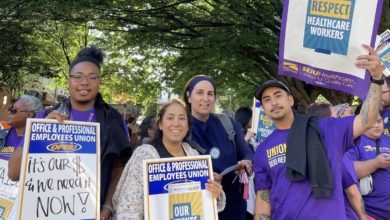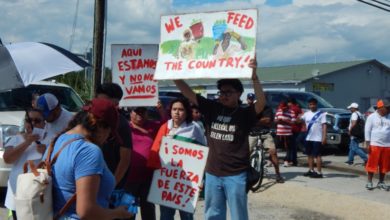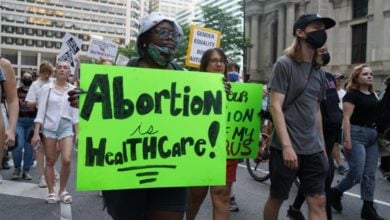We cannot allow the capitalist ruling class to turn a blind eye to the plight of the incarcerated population — not in general, nor in the particular circumstance of the global pandemic of Covid-19. In the U.S., there are 2.3 million human beings in state, federal, and county jails and more than 52,000 in immigrant detainment camps. Around the country, organizations and coalitions are calling for the immediate release of incarcerated people who are particularly vulnerable to COVID-19. The Party for Socialism and Liberation and La Riva/Peltier election campaign raise these demands as well.
Corona virus and prisons, jails, and ICE detention
It is impossible to quarantine in the context of incarceration. Every prison, jail, juvenile facility, and immigrant detention center will become an incubator of the deadly corona virus. Social distancing is physically impossible in lower security facilities. Inmates are in gate group cells usually made up of four to five 50-person cells. Even as big as 100-person dormitories exist in other facilities. In higher-security prisons, a facility-wide lock-down entails a 24-hour confinement in one’s cell. This of course would mitigate recreation time in the yard as well as congregating in the prison cafeteria. Yet serving meals to locked-up inmates could still spread the virus. All regular cell searches put inmates in contact with correctional officers who are already bringing the virus into work from outside contacts.
Jails are already compromised in dozens of counties. Jails hold all people who are either awaiting trial or for transfer to a prison. Since jails are filled and overcrowded with people abducted from their communities, there are almost certainly more people carrying the virus than the few cases documented. Few COVID-19 test kits are available to gauge the real numbers.
Similarly, immigrant detention centers are group encampments already suffering from heap-like conditions, and detainees cannot be given adequate physical distance. Because of overcrowding and a lack of physical institutions, immigrant detainees are regularly rerouted to jails where many infections have already been documented. Immigrants are denied due-process rights and are jailed for coming to the U.S. seeking work or refuge.
Size and scope of the problem
In some cases, such as the infamous Rikers Island Jail in New York City, as many as 21 inmates and 17 correctional officers have already tested positive for the corona virus as of March 20, with already one death of an investigator. Urgent action is necessary. Presumably, every incarcerated person will be transferred to upstate New York prison facilities pending trial, compromising state prisons more pervasively. This is true everywhere people are bused en mass from the jails to the prisons.
In all cases, prisons, jails, and immigrant detention camps suffer the same inhumane and unsanitary conditions. Incarcerated people often lack access to regular running water, hot water, regular shower privileges, hand sanitizer (because they contain alcohol), and hand soap. An observation from formerly incarcerated people on the depictions of prisons in movies and TV shows is that they are shown to be clean. The reality is that mold is a common occurrence, and rodents, roaches and grime accompany the crumbling infrastructure of the country’s repressive apparatus.
Already across New Jersey, hunger strikes have cropped up in three facilities holding immigrant detainees, for lack of cleaning measures and a shortage of soap.
Similarly, the food served in these facilities is criminally insufficient. Prisons tip-toe on the minimum threshold for legally required calories provided for breakfast, lunch and dinner. Incarcerated people often depend on family support for funds to buy candy, ramen noodles, and chips from commissary at massive markups. This plays no small part in the prevalence of chronic health conditions in prisons.
Most studies conclude that the incarcerated population is many more times likely to be victim to chronic health conditions such as asthma, arthritis, diabetes, hypertension, sexually transmitted diseases, cancer or myocardial infarction.
According to the U.S. Department of Justice, 73 percent of prison inmates and 77 percent of jail inmates report chronic conditions at admission, and only 44 percent claim to be satisfied with the medical care compared to the care they received prior to incarceration: “Nearly half (48 percent) of prisoners and 43 percent of jail inmates reported that the health care received while incarcerated was better than or about the same as the care they received in the 12 months prior to admission.”
One can conclude that the latter response is because the inmates were not previously receiving health care outside.
Wardens and correctional officers in a pigpen scramble
Around the country, health care workers, lawyers, prisoner rights activists, abolition groups, and even some corrections boards have called for the urgent release of inmates considered high risk.
Earlier this week Los Angeles County began releasing hundreds of low-level inmates to reduce the possibility of infection, and New York City Mayor Bill De Blasio said his city was considering similar measures. A decisive factor in this decision is not so much the moral uprightness of the authorities in control. Rather, corrections officers are calling in sick at much higher rates, and medical wings of the facilities are understaffed, under-resourced and over-burdened. Ohio corrections initiated a similar pressure-valve type of release. The United States repressive apparatus is cracking at the seams with this contradiction. Corrections associations and inmates alike are citing the inevitability of rebellion as the times get tougher.
The real possibility of losing control of the prisons looms over the heads of prison administrations everywhere. Robert Hood, a former warden of Colorado’s “Supermax” federal penitentiary, told ABC news: “All of the sudden the guys that are the best inmates, the 50% to 60% who are in for drug-related, non-violent offenses, the guys in the dormitories — not the lockdown guys — all of a sudden they’re at the most risk. What would I do if I was an inmate in a dormitory? I’d go smack someone in the head — and I mean that. I’d want to go on lockdown, because then I’d be a little better off.”
The call for release of at-risk prisoners is not consistent across the country. In fact, there may be a monetary incentive to keep them incarcerated. New York Governor Cuomo boasted that prisoner-made hand sanitizer was a superior product to anything else on the market. At a press conference, Cuomo gleefully announced, “Open the curtain please!” to show a line of New York State hand sanitizers created by CorCraft, which uses prison labor at 16 cents to $1.14 an hour. He then applied the CorCraft company hand sanitizer to describe it having the scent of a floral bouquet. In short, Cuomo sees the crisis as an opportunity to extract super profits from prison labor.
What is more, the “Pandemic Influenza Surge Plan for Managing In- and out-of-Hospital Deaths,” published by the New York City Chief Medical Examiner’s Office in 2008, explains that the city’s Department of Corrections manages a mass grave site on Hart Island for people unable to afford burials. This grave site is currently worked by prisoners, and has been for the last 150 years. Thus, instead of a compassionate release on a massive scale of incarcerated human beings, the city plans to force prisoners to bury potentially massive numbers of people, including their own imprisoned brothers and sisters, in the event of mass deaths due to the COVID-19 crisis.
Crisis always comes to the prison; prisons are the crisis
A major contradiction has become clear one week into the corona virus pandemic: Capitalism is not capable of handling a global crisis. In the United States, this is particularly acute. The lack of access to health care, the 40 percent of the U.S. population that has only an average of $400 in personal savings, the millions who face layoffs and shutdowns, the massive homeless population amid the glut of empty houses and luxury condos, the vast food deserts, and the lack of a sufficient social safety net are now everywhere on display in their most brutal forms. Seldom remembered are the lives of 2.3 million people brutally incarcerated in America’s prisons and their families who also suffer from the imprisonment.
Every experienced prisoner-rights and abolition organizer knows that each time a hurricane approaches the United States the race is on to urge wardens and corrections boards to evacuate the prisons. In one particularly terrifying case, the inmates of Orleans Parish Prison were left to drown as Katrina swept in and guards abandoned the prison without opening the cells. Inmates were stranded neck deep in sewage water without food or drinking water for nearly a week. Some 517 of these incarcerated people are still unaccounted for.
How many hurricanes, tornadoes, earthquakes, influenza, and pandemics will have to devastate the incarcerated population before decisive action towards a better future is taken? Some theories refer to the U.S. government as a “carceral state,” a state that funnels its problems into incarceration measures. Crime rates in this country don’t match incarceration rates nearly as much as with unemployment, homelessness, and poverty rates. In short, the carceral state is the capitalist state, which exists to manage the affairs of a shrinking but wealthier ownership class amid a colossal working class (employed, unemployed, homeless, or incarcerated) scrounging to get by. One of the capitalist state’s greatest weapons in its racist class war has been the prisons.
The urgent action of early and compassionate release of prisoners with the COVID-19 crisis has already taken place in other parts of the world: Iran released one-third of its total prison population in response to the exigencies produced by the virus, some 85,000 temporarily freed people.
In the name of humanity
The 10-point program of the Gloria La Riva and Leonard Peltier presidential campaign addresses economic and social crises with radical solutions. Three points of the 10-point program are here especially relevant:
★ 3 | End racism, police brutality, mass incarceration — Pay reparations to the African American and Native communities.
Mass incarceration and racist policing are symptomatic of the 400 years of brutal repression meted out to African-descended peoples in the U.S. and the genocide committed against the Native nations. Reparations must be paid to the African American and Native communities! More than 2.2 million people are behind bars in the largest prison complex in the world. End mass incarceration of oppressed and working-class people. Fully prosecute all acts of police brutality and violence. Free Leonard Peltier, Mumia Abu-Jamal and all political prisoners!
Adding to this demand in light of COVID-19, we call for the compassionate release of all elderly prisoners and those with chronic health conditions. The population of prisoners age 55 over has increased 400 percent in the last 20 years. For those who remain in the prison system, we demand radical reforms focused on humanizing the conditions, including paying prisoners at least minimum wage for their labor, stopping punitive punishment like isolation cells and extraction teams, and expanding educational and rehabilitation programs.
The immediate release of all pre-trial detainees, who can return to court after they’re reopened after the crises, and immediate freeing of those with release dates in 2020 and 2021. There are as many as 612,000 people in local jails who are not convicted — that is, they are legally innocent. Only 32,000 of this population are considered violent, yet many deemed violent by the capitalist state only have enhanced statuses because of poor representation in the courts and, for many African American inmates, wrongful convictions. There are of course exceptions to the issue of general release, but they can be reviewed by peer boards not traditionally in the hands of the repressive state apparatus.
The immediate release of all youth prisoners (46,000) to return to their families or safe homes with guidance counselors to help in true rehabilitation.
At a federal level the majority of incarcerated people are in for public order (the preferred term to victimless crime) and property crimes. In almost all cases, these people could now be released from their 40- to 50-year sentences.
State Prisons make up the majority of incarcerated people, and similar to the other categories: public order, DUI, (racist) drug crimes, property crimes make up the vast majority. Almost 100 percent of these inmates should be freed.
Freedom for all people incarcerated on parole or probation violation (often failures to check in), for petty marijuana or alcohol consumption, “police contact,” or failure to pay for ankle monitors or restitution. In addition, freed prisoners need sufficient funds to be able to find housing and income until they are employed. Free education should also be offered as well as job training.
★ 4 | Full rights for all immigrants
Abolish all anti-immigrant laws. Stop the raids and deportations and demonization of immigrants. Shut down ICE and the concentration camps and reunite families. The government’s war on immigrants must end. The border wall must be dismantled. Amnesty and citizenship for those without documents. Full rights for all!
All 61,000 immigrant detainees should be free. As the immigrant detainees have said in the New Jersey hunger strike, “If we have to die, we would rather die out there than in here!” This would entail not only closing all ICE camps and disbanding ICE but also releasing immigrant detainees who have been placed in local jails as overflow.
★ 10 | Take over the stolen wealth of the giant banks and corporations — Jail Wall Street criminals
The vast wealth of the giant banks and corporations is created by workers’ labor and the exploitation of the world’s diminishing natural resources. The billionaires looted and destroyed the economy. It is time to seize their assets and use those resources in the interests of the vast majority. Power must be taken out of the hands of the super rich, and Wall Street criminals must be jailed.
Point 10 in the La Riva Program stands out in the context of $1.5 trillion stock market bailouts in response to the crisis. The billionaires have certainly shown solidarity with their own class. So much pain and death could be avoided if they were not the ruling class. If anyone belongs in jail, it is the bankers and the gangsters in the Pentagon and the White House.
Prisoner self-determination
We cannot hope to divine a new society on the basis of our imaginations alone. We can, however, say that the rest of the world operates with a fraction of our prison population. While the freedom of say 80 percent of the U.S. prison population would seem magical in its scope, it would still leave 500,000. That would place the U.S. fourth in total people incarcerated. The U.S. would still be in the running for the highest incarceration rate per capita.
Because the media pounds away at the population with such negative coverage of prisoners — diverting attention from the real capitalist criminals — the idea of many people being freed from the prisons, jails, and immigrant detainment centers could cause a negative reaction. But liberation is nothing to fear. What is truly scary is the idea that this racist mass incarceration system could be one large mass grave in the context of a global pandemic.





